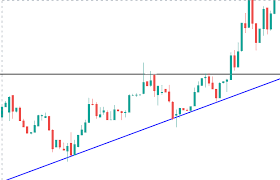Profit from triangle chart pattern formations

Simple, easy profit from triangle formations
Triangles accommodate one of the most useful and easy to execute price pattern formations. An traditional triangle pattern as well referred to as a wedge or pennant is a worthful signal prior to a relatively predictable price difference. The odds favor a strong directional move from a breakout of a triangle pattern, particularly in a continuation breakout of the prevailing trend. Continuation patterns hint that the temporary pause in directional price movements is just that only a temporary pause.
Overview of triangle patterns
When the top and bottom trendlines form a triangle a worthful sign is formed, many times forecasting a sharp subsequent movement when the price breaks out. The wider the price fluctuations within the triangle, and the longer the triangle pattern holds, the greater the pursuing price difference. Good triangles are an intermediate pattern, taking from one to three months to form.
There are four diverse types of triangles:
- symmetrical
- ascending
- descending
- expanding
Symmetrical triangles consists of two converging trend lines (upper line goes lower and lower line goes higher). The point at which they cross is called top. Note the classic triangle formation on the daily chart of the USD/JPY pair below.
There have to be at least four reversal points as to for a triangle to be recognized, but there may be more (for example, six: three peaks and three troughs).
In most cases the breakout occurs in the middle to three-quarters of the triangle width. If within three-quarters of the triangle width the breakout has not occurred, the subsequent price action will be weak and difficut to predict. The fewer price fluctuations inside the triangle, the more chances that trading volume will reduce (this is a standard rule for most continuation patterns).
The formation ends when a trendline is broken. It is sometimes followed by a pull back to the trend line (if it was an upside breakout then it would be help level if downside breakout it would be the resistance level. The top of the triangle will be the imperative help/resistance level. To estimate if the triangle line breakout is true, please refer to the methods previously used to experiment trend-line breakouts.
Ascending triangle is a type of symmetrical layout. Its upper trend line is horizontal whereas the lower one is upward sloping. This is a bullish formation as in this scenario buyers are more active than sellers. When an ascending triangle develops, it is usually a good chance for an upside breakout to occur.
Ascending triangles are usually formed as a continuation pattern in an uptrend, but sometimes they can be found at the bottom of a downtrend, signaling a reversal. Even if the market is bearish this chart pattern ought to be advised as bullish.
Descending triangle is a bearish formation, a mirror image of an ascending triangle.
How to analyze symmetrical, ascending and descending triangles
- Classic triangle has five lines (three downward and two upward or vice versa).
- If the price penetrates the triangle downwards then the price may sustain to fall.
- If the price penetrates the triangle upwards the price may sustain to rise.
- If the pattern angle is up-directed the price may move higher.
- If the pattern angle is down-directed the price may move lower.
- If prices stay within the triangle beyond the three-quarter point, the triangle starts to drop its potency, and prices may sustain to drift out to the apex and beyond.
- Triangle top will be the help/resistance level.
- Typically, volume is heavy at the onset and it contracts during the formation of a triangle. It increases again during the breakout.
- The price continues moving in the direction of the breakout for at least a gamut equal to the triangle’s height.
Expanding triangles which usually appears at market highs consists of three increasingly rising highs and two increasingly falling bottoms.
comments